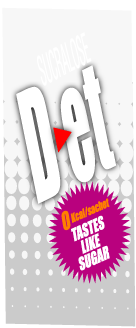
|
SUCRALOSEFrom the International Sweeteners Association(Updated July 19, 2003).DESCRIPTIONSucralose is the common name for a new high-intensity sweetener derived from ordinary sugar. It has been developed jointly under an agreement between McNeil Specialty Products, a subsidiary of Johnson & Johnson, and Tate & Lyle Speciality Sweeteners.RELATIVE SWEETNESS600 times sweeter than sugarMETABOLISMSucralose does not break down in the body; it is non-caloric. BENEFITSSucralose has a high quality of sweetness, good water solubility and excellent stability in a wide range of processed foods and beverages. When combined with other low-calorie sweeteners, it has a synergistic sweetening effect. Like sugar, sucralose will hydrolyse in solution, but only over an extended period of time under extreme conditions of acidity and temperature.Sucralose does not promote tooth decay. APPLICATIONSSucralose can be used in a broad array of products, including:
SAFETYExtensive studies have been conducted to support the safety of sucralose. The results of these studies demonstrate that it is safe for human consumption.STATUSSucralose is currently approved for use in foodstuffs in more than 35 countries around the world. In September 1991, the Canadian government permitted the use of sucralose. Approvals were also granted in Australia and Russia (in 1993) and in Mexico, Qatar (Middle East) and Romania. (1994). In April 1998 sucralose was approved for sale in the United States. In August 1999 the American Food & Drug Administration (FDA) published their approval of sucralose as a "general purpose sweetener in foods". This means that sucralose can be used in any food at GMP (Good Manufacturing Practice) levels in the USA.In June 1999 Singapore allowed sucralose to be imported and sold. On July 30th 1999 the Japanese Ministry of Health and Welfare designated sucralose as an approved food additive. In January 2000 Chile approved the use of sucralose. Having been approved by the European Union's Scientific Committee on Food in September 2000, sucralose is currently part of the Proposed Amendment to Directive 94/35/EC on sweeteners in foodstuffs. The adoption of this by the European Council and Parliament can be expected during the course of 2003. ADIThe Acceptable Daily Intake (ADI) for sucralose was set at 0-15 mg per kilogramme of bodyweight by the Joint FAO/WHO Expert Committee on Food Additives (JECFA) in 1990 and by the European Commission's Scientific Committee on Food in September 2000. |
|||||
|
Visitor Counter since 7/4/2006 |
U-Sing Co.,Ltd. 136/10, Soi Bangkhunnon20, Bangkhunnon, Bangkoknoi, Bangkok 10700 THAILAND Phone: +66-2433-7317 Fax: +66-2433-7316 Product Inquiry | Technical Problem | Commercial Contact |
||||










